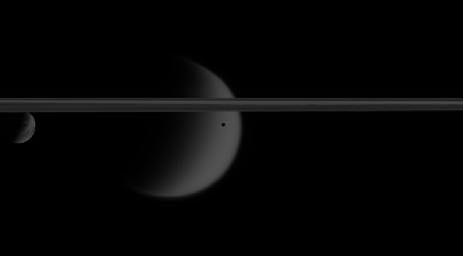
|
Staying with Epimetheus
- Click the image above for a larger view
 Movie Download Options
Movie Download Options- Full-Res JPEG (950 x 420) (11.5 kB)
- Full-Res TIFF (950 x 420) (399.7 kB)
Caption:
Three of Saturn's moons swim past in this movie sequence of images from the Cassini spacecraft. These sequences, called mutual events, are useful for refining scientists' understanding the orbits of the moons.
The movie follows Epimetheus (116 kilometers, or 72 miles across) as it passes in front of Titan (5,150 kilometers, or 3,200 miles across) and then Dione (1,126 kilometers, or 700 miles across).
The faint object that appears at the left, below the ringplane, halfway through the movie is a background star.
The movie was created using 24 clear-filter images taken over a period of about 40 minutes. The images were acquired by the Cassini spacecraft narrow-angle camera on Jan. 5, 2006, at a mean distance of approximately 3 million kilometers (1.9 million miles) from Epimetheus. The image scale is approximately 18 kilometers (11 miles) per pixel on Epimetheus, 25 kilometers (16 miles) per pixel on Titan and 20 kilometers (12 miles) per pixel on Dione.
Background Info:
The Cassini-Huygens mission is a cooperative project of NASA, the European Space Agency and the Italian Space Agency. The Jet Propulsion Laboratory, a division of the California Institute of Technology in Pasadena, manages the mission for NASA's Science Mission Directorate, Washington, D.C. The Cassini orbiter and its two onboard cameras were designed, developed and assembled at JPL. The imaging operations center is based at the Space Science Institute in Boulder, Colo.
For more information about the Cassini-Huygens mission visit http://saturn.jpl.nasa.gov/ . The Cassini imaging team homepage is at http://ciclops.org .
Cataloging Keywords:
| Name | Value | Additional Values |
|---|---|---|
| Target | Epimetheus | Dione, Titan |
| System | Saturn | |
| Target Type | Satellite | |
| Mission | Cassini-Huygens | |
| Instrument Host | Cassini Orbiter | |
| Host Type | Orbiter | |
| Instrument | Imaging Science Subsystem (ISS) | |
| Detector | Narrow Angle Camera | |
| Extra Keywords | Grayscale, Movie, Visual | |
| Acquisition Date | ||
| Release Date | 2006-06-22 | |
| Date in Caption | 2006-01-05 | |
| Image Credit | NASA/JPL/Space Science Institute | |
| Source | photojournal.jpl.nasa.gov/catalog/PIA07802 | |
| Identifier | PIA07802 | |
